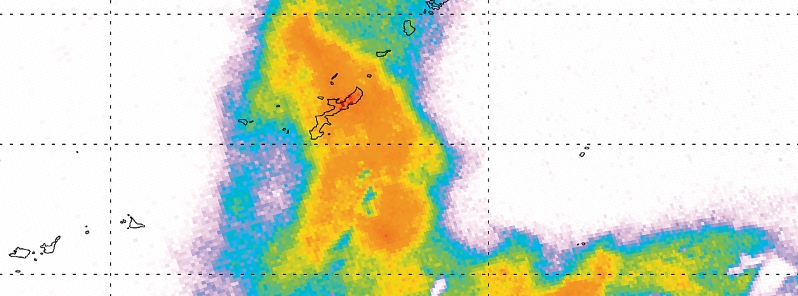Continuous explosive activity, strong sulfur dioxide emission over Suwanosejima volcano, Japan

Continuous explosive activity was reported at Japan's Suwanosejima volcano over the past several days, with another eruption recorded on Thursday, August 6, 2020, in which the ash plume reached up to 2.3 km (7 000 feet) a.s.l. The Alert Level remains at 2 (on a 5-level scale) since December 1, 2007.
JMA is reporting continuous activity at Suwanosejima volcano over the past weeks, with several notable explosions and nighttime incandescence at Ontake Crater.
An explosion on July 27 generated a gray plume that rose as high as 2 km (6 550 feet) above the crater rim.
According to the Tokyo VAAC, ash plumes rose to 1.8 – 2.4 km (6 000 – 8 000 ft) a.s.l. from August 1 to 3 and drifted NW and W.
On August 4, a satellite image from Tropomi showed strong sulfur dioxide (SO2) emissions that extended to the south of the volcano across the Pacific Ocean.
According to Tokyo VAAC, the last eruption at the volcano took place at around 01:21 UTC (10:21 LT) on August 6, spewing ash up to 2.3 km (7 000 feet) a.s.l., extending NE.
Last night the #volcano(#火山) of #Suwanosejima(#諏訪之瀬島) of #TokaraIslands(#トカラ列島) in #Kagoshima(#鹿児島) was erupting out gray smokes,
at 20:58, Aug. 5, 2020(JST). #A shootingstar(#meteor)(#流星) arrived in the south sky over the volcano. ☆彡
Japan. pic.twitter.com/Ve1BpztEgY— Nature of Terrestrial Planet (地球型惑星の自然) (@TaTohru) August 6, 2020
On 2020-08-04 #TROPOMI has detected a strong SO2 signal in the vicinity of #Suwanose-jima with 13.21DU of SO2. @tropomi #S5p #Sentinel5p @DLR_en @BIRA_IASB @ESA_EO #SO2LH pic.twitter.com/Gx5XFW0rrw
— TROPOMI SO2 (@DlrSo2) August 5, 2020
Volcano Suwanosejima plume between 00:00 – 05:13 jst time pic.twitter.com/MmJG1GJzQx
— VolcanoYT (@VolcanoYTz) July 31, 2020
Geological summary
The 8 km (5 miles) long, spindle-shaped island of Suwanosejima in the northern Ryukyu Islands consists of an andesitic stratovolcano with two historically active summit craters. The summit is truncated by a large breached crater extending to the sea on the east flank that was formed by edifice collapse.
Suwanosejima, one of Japan's most frequently active volcanoes, was in a state of intermittent strombolian activity from Otake, the NE summit crater, that began in 1949 and lasted until 1996, after which periods of inactivity lengthened.
The largest historical eruption took place in 1813-14 when thick scoria deposits blanketed residential areas, and the SW crater produced two lava flows that reached the western coast.
At the end of the eruption, the summit of Otake collapsed forming a large debris avalanche and creating the horseshoe-shaped Sakuchi caldera, which extends to the eastern coast. The island remained uninhabited for about 70 years after the 1813-1814 eruption. Lava flows reached the eastern coast of the island in 1884. Only about 50 people live on the island.
Featured image credit: DLR/BIRA/ESA

Commenting rules and guidelines
We value the thoughts and opinions of our readers and welcome healthy discussions on our website. In order to maintain a respectful and positive community, we ask that all commenters follow these rules.